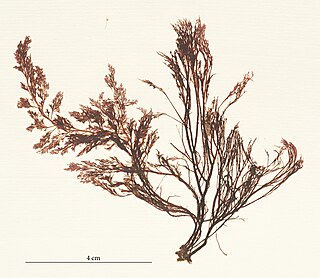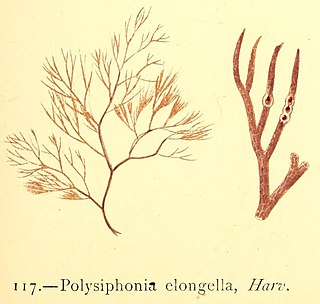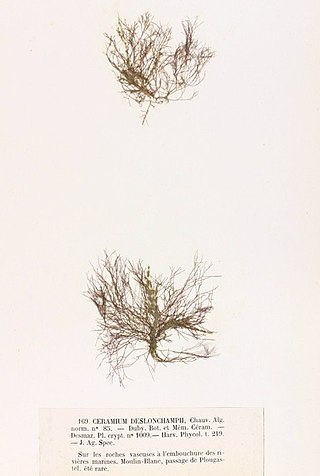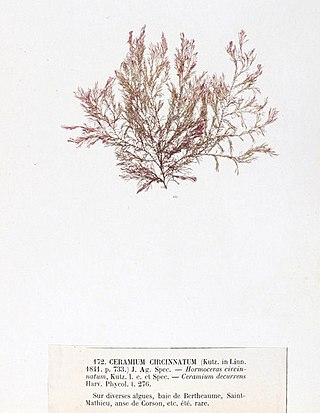
Atractophora hypnoides is a rare red alga (Rhodophyta) found in the British Isles, France and some Atlantic Islands and is the only species of the genus found in the British Isles. It is attached to the rock or other algae by a small basal disc and is much branched with downgrowing filaments which enclose the main branch or axis forming a cortex. Short filaments of limited growth radiate in whorls from the axis and frequently convert into hairs. The spreading filaments grow irregularly in a diffuse manner. Microscope examination is required for identification.

Polysiphonia ceramiaeformis, also called banded siphon weed, is a small red algae (Rhodophyta), in the genus Polysiphonia. Individuals are irregularly branched with the branches extending up to 5.5 centimetres (2.2 in) from a central node and ending in dense tufts of fibres.
Polysiphonia denudata is a small red alga, Rhodophyta, growing as tufts up to 20 cm long without a main branch axis.
Polysiphonia devoniensis is a species of marine algae. It is a small red alga in the Division Rhodophyta. It is a species new to science only described recently and first published in 1993.

Polysiphonia elongata is a small red marine algae in the Rhodophyta.

Polysiphonia elongella Harvey in W.J. Hooker is a branched species of marine red algae in the genus in the Polysiphonia in the Rhodophyta.
Polysiphonia fibrata is a species of Polysiphonia that grows as small dense tufted and finely branched marine alga in the Rhodophyta.
Polysiphonia furcellata (C.Agardh) Harvey is small marine red alga in the Division Rhodophyta.

Polysiphonia simulans is a small marine alga in the division Rhodophyta.

Ceramium echionotum is a small marine alga in the division Rhodophyta.

Ceramium ciliatum is a small marine red alga in the Division Rhodophyta.

Ceramium deslongchampsii is a small marine red alga in the Division Rhodophyta.
Ceramium pallidum is a small marine alga. It occurs in waters off of Europe and Africa (Morocco).

Ceramium circinatum is a small marine red algae.

Hypoglossum hypoglossoides, known as under tongue weed, is a small red marine alga in the family Delesseriaceae.

Phycodrys rubens is a red marine alga of up to 30 cm long.

Phyllophora crispa is a medium-sized fleshy, marine red alga. This alga forms dense mats of up to 15 cm thickness, which influence environmental factors, thus creating habitat for several associated organisms.
Phyllophora sicula, the hand leaf bearer, is a small red marine alga.

Odonthalia dentata is a medium-sized marine red alga.

Lithophyllum incrustans, also known by its common names coraline crust and paint weed, is a small pinkish species of seaweed.













